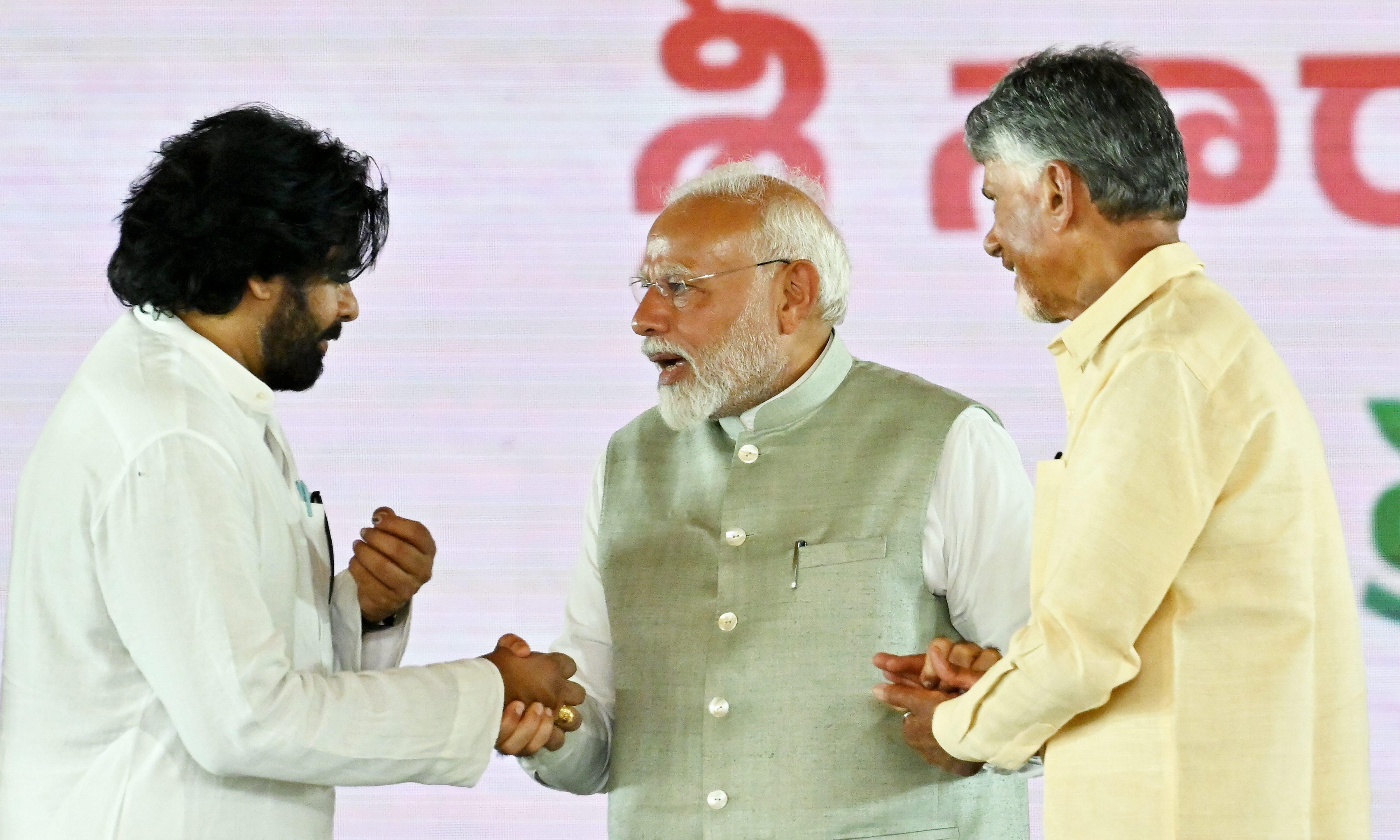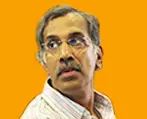
- Home
- India
- World
- Premium
- THE FEDERAL SPECIAL
- Analysis
- States
- Perspective
- Videos
- Sports
- Education
- Entertainment
- Elections
- Features
- Health
- Business
- Series
- In memoriam: Sheikh Mujibur Rahman
- Bishnoi's Men
- NEET TANGLE
- Economy Series
- Earth Day
- Kashmir’s Frozen Turbulence
- India@75
- The legend of Ramjanmabhoomi
- Liberalisation@30
- How to tame a dragon
- Celebrating biodiversity
- Farm Matters
- 50 days of solitude
- Bringing Migrants Home
- Budget 2020
- Jharkhand Votes
- The Federal Investigates
- The Federal Impact
- Vanishing Sand
- Gandhi @ 150
- Andhra Today
- Field report
- Operation Gulmarg
- Pandemic @1 Mn in India
- The Federal Year-End
- The Zero Year
- Science
- Brand studio
- Newsletter
- Elections 2024
- Events
- Home
- IndiaIndia
- World
- Analysis
- StatesStates
- PerspectivePerspective
- VideosVideos
- Sports
- Education
- Entertainment
- ElectionsElections
- Features
- Health
- BusinessBusiness
- Premium
- Loading...
Premium - Events

Though Nitish Kumar is called ‘Paltu Ram’ for his U-turns, Naidu could teach him a thing or two on opportunism and political somersaults
When the primary option fails, strategists often opt for a contingency plan.
Similarly, politicians aiming for continued electoral success meticulously devise backup plans, well aware of the inherent risks in implementing their original strategy.
Seat targets
For instance, after Narendra Modi set an ambitious target of securing 370 seats in the Lok Sabha for the BJP and 400 with the assistance of National Democratic Alliance (NDA) allies, he strategically considered the southern states as a potential source of additional support in case of a shortfall in numbers. This foresight essentially served as his Plan B.
In the scenario where the contingency plan or Plan B fails, strategists often resort to a fallback plan, or Plan C. While the fallback option may not be foolproof, it usually represents a familiar course of action.
If Plan B were to fail for Modi, for instance, due to Chandrababu Naidu withdrawing support, he would have to have Plan C as a backup.
Modi’s Plan B
So far, Modi's implementation of Plan B has yielded significant dividends. Through the NDA alliance, he managed to secure an additional 20 seats from the southern states.
In the 2019 Lok Sabha elections, the BJP independently secured 29 of 130 seats in the South. The NDA hardly existed then.
Furthermore, the BJP acquired an extra seat when late Kannada actor Ambareesh's wife Sumalatha, who contested as an Independent and won from Mandya, joined the BJP in April this year.
In the 2024 elections, the BJP secured the same number of 29 seats from the southern region, while the NDA, led by the BJP, managed to secure 47 seats.
Despite this apparent success, Modi will have to look over his shoulder to keep the NDA intact.
Nitish vs Naidu
Though Bihar Chief Minister Nitish Kumar is called 'Paltu Ram’ for his U-turns, Naidu could teach him a thing or two on opportunism and political somersaults, a trait he has excelled in over his 46-year-long career.
Naidu, who started his political journey as a Youth Congress leader in undivided Andhra Pradesh alongside Y Rajasekhara Reddy (YSR), saw diverging paths in his and YSR's political trajectories.
Rising to become the country's youngest minister at the age of 30, Naidu maintained his loyalty to the Congress party, despite being married into the family of the legendary NT Rama Rao (NTR), who founded the Telugu Desam Party (TDP), aimed at challenging Congress dominance.
Naidu even once threatened to contest against his father-in-law.
Strategic shift
However, circumstances evolved, leading Naidu to make a strategic shift towards the TDP as he perceived a decline in the Congress’ influence. In contrast, YSR continued his allegiance to the Congress and emerged as one of its most influential chief ministers.
Decades later, after YSR died in a helicopter crash, the political landscape saw a fierce rivalry between YSR's son, Jagan Mohan Reddy, who broke away from the Congress to establish the YSR Congress Party, and Naidu. It set the stage for a contentious political showdown.
In 1984, Naidu proved his mettle as a crisis manager when NTR was away in the US undergoing medical treatment. He defused a crisis when the Congress propped a rebel TDP leader N Bhaskar Rao as the chief minister.
Subsequently, the TDP was unseated and in 1989 Naidu emerged as an effective Opposition leader in the Andhra assembly.
Palace coup
In 1994, Naidu won the Kuppam seat and became an influential minister in NTR’s cabinet. Soon he staged a palace coup and unseated his father-in-law to take the chief ministership. Naidu was seen as someone who pulled the TDP out of a crisis caused by Lakshmi Parvati, NTR’s controversial second wife.
Dramatically, in 1996, Naidu burst onto the national scene. For the next two years, he would be the toast of the Left and secular forces. As convenor of the 13-party United Front government, he facilitated the appointment of two prime ministers — HD Deve Gowda and the late Inder Kumar Gujral.
Three years later, in 1999, he took a rightward leap and tied up with the BJP to win a record 29 Lok Sabha seats. The victory enabled him to extract concessions from then Prime Minister Atal Behari Vajpayee, to whom he gave an ‘issue based support’.
During that period, then Gujarat Chief Minister Narendra Modi, too, faced Naidu's barbs for failing to quell the Godhra riots.
Setbacks for Naidu
The Congress staged a comeback in 2004 with YSR as the Chief Minister of Andhra Pradesh. Naidu was again defeated in the 2009 Assembly polls. He blamed superstar Chiranjeevi’s Praja Rajyam Party, or PRP, for dividing Opposition votes.
In 2014, when Andhra Pradesh was bifurcated, he had no hesitation in allying with the Jana Sena Party, launched by Pawan Kalyan, Chiranjeevi’s brother. Pawan had been the leader of PRP's youth wing.
Naidu also had no qualms in tying up with Modi’s BJP. The U-turns helped him return to power in 2014.
In 2018, his relationship with the BJP deteriorated and he pulled out two TDP ministers from Modi’s cabinet, protesting against the Centre’s failure in granting special status to Andhra Pradesh.
Back with Congress
A year later, in 2019, he allied with his arch-enemy-for-decades, the Congress party, to fight parliamentary elections, and lost. He remained in the wilderness for a while and struggled to return to the NDA.
Meanwhile, Jagan Mohan Reddy, as Andhra Pradesh Chief Minister, began to exert pressure on Naidu and jailed him in an alleged corruption case.
Earlier, in the state Assembly, facing a barrage of allegations, Naidu pledged to return to the Lower House only as a chief minister.
Unique approach
In 2024, his prayers were answered as the BJP struck an alliance with the TDP and Jana Sena and went into Lok Sabha and Assembly elections.
The alliance got a rich haul of 21 Parliament seats. Of these, the BJP on its own got three seats and, for the first time, found berths in the state cabinet. The YSRCP, though not formally part of the NDA, is still backing the BJP in Parliament.
Like Naidu, Pawan Kalyan too is likely to be guided by self-interests and opportunism. He started his political career with elder sibling Chiranjeevi. Soon he broke off when differences surfaced between them.
Pawan launched the Jana Sena in 2014 and backed the BJP, but opposed the same party tooth and nail in 2019, accusing it of trampling upon the rights of southern states. In 2024, he had no qualms tying up with the same saffron outfit.
Unique approach
Aware of the political skullduggery in Andhra Pradesh, the BJP may have readied its familiar course of fallback Plan C, which is striking a deal with Pawan Kalyan.
Reports suggest that breaking away from the tradition, the images of both Chief Minister Naidu and his deputy, Pawan Kalyan, have begun to grace the walls of official chambers side by side in Andhra Pradesh.
This unique approach raises questions about Naidu's intentions — is this a subtle way for Naidu to fortify the alliance's unity in anticipation of potential challenges or discord?


